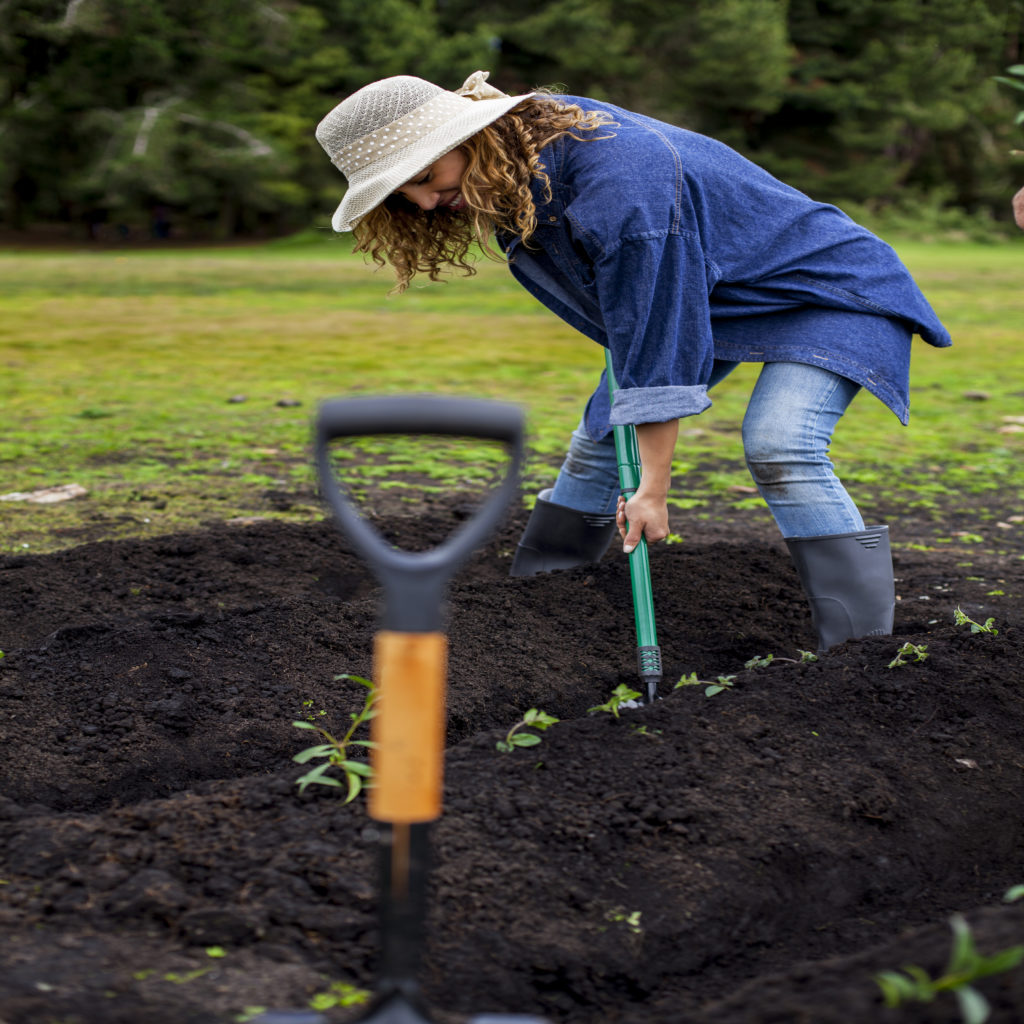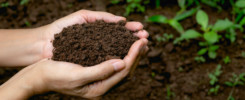
Submitted By: Egan Davis, Principal Instructor (UBC Botanical Garden)
In a previous article, we discussed the importance of healthy soil. However, to learn more about soil, you need to use your senses by looking, touching and smelling it. Here is a good field test that you can easily do without specialized tools or equipment. As you go through the various steps to analyze your sample, keep these questions in mind:
- What is this soil made of?
- How porous is this soil?
- How nutritious is this soil?
- How would the qualities that you observe affect plant and other biological life in the soil?
Assessing Soil Quality – Look, Feel and Smell
First, be sure to use a good sample. If you just take one scoop and proceed, your sample will not be a good representation of the whole area you want to test. Using a trowel, take a number of soil collections within the test area and put this soil in a bucket. If you are testing a small area like the root zone of one particular plant, take five collections to make a sample. The larger the area, the more collections you should take to ensure that you have a good sample. A raised bed might require ten collections and a large plot may require up to 20 collections. Make sure that you do not include any mulch or surface litter that is present. After gently mixing the collections, you will have a sample that is well-representative of the whole area that you are testing.
Look
Before you look closely at the soil, look at the site you are sampling. Are plants growing there already? Do they look healthy? The old adage, “If it ain’t broke, don’t fix it” comes to mind here. There is no sense making major changes to a system that is already working.
Is there any cover, such as a mulch or a groundcover of plants on the surface of the soil? It is rare to see bare soils in nature. You will often find coverings such as leaf and twig litter, plant groundcover or rock covering the soil. Even soils that appear to be bare, like in the desert, will have a crust of microscopic fungal strands (called fungal mycelium) protecting the surface. Covering soil is important as it provides habitat and nutrient recycling materials while limiting weed growth and reducing root competition between plants. This cover also prevents the soil from drying out in the sun, and protects the soil from erosion in the rain.
Now look carefully at the soil, itself. You can tell a lot about soil quality just by looking at it. The colour of the soil can indicate the level of organic content. Decomposed organic matter is a dark brown/almost black colour. If the soil is dark in colour, it is a likely indication of a rich organic component. Soils that are lighter brown in colour likely have lower levels of organic content. Decomposed organic matter not only improves nutrition, it also behaves like a glue by binding mineral particles together, creating peds and improving porosity. Keep in mind that although most plants appreciate the moisture-holding and nutritious qualities of organic soils, some plants grow very well in lean sandy soils. For example, many herbs such as rosemary, sage, thyme and oregano grow very well in mineral soils that are sandy and dry. Colour can also indicate oxygen levels in the soil. Red and orange colours may indicate highly aerated, oxygen-rich soils. Soils that are grey (or bluish-grey) can be an indication of low oxygen levels.

When looking at soil, you can also gauge how well-structured (and thus, how porous) the soil is.
- Are the mineral particles bound together into pea-sized peds? This is ideal for most plants as space will exist between the peds, facilitating water, air and root movement.
- Is the soil sandy with large grains that are not bound together? Large, single grains of sand may not be bound together, but may still provide good soil porosity. Single grain structured soils tend to be nutritionally lean and dry, which is actually beneficial to a whole range of plants.
- Does the soil stick together in large, heavy clumps? This may be an indication of poorly structured, wet or compacted conditions. Most plants will perform better in porous soils but again, there are plants that are well- adapted to heavier soils. For example, robust perennials such as iris Solomon’s seal and hosta do well in heavier soils.
Touchy-Feely Soil Testing
Ok, now it is time to get your hands dirty. With these next few observational tests, the strategy is to determine the texture of your soil (or in other words, the size of the soil’s mineral particles).
- Coarse textured soils are sandy and typically low in nutritional value. Their structure can be damaged easily.
- Fine textured soils such as silts and clay retain a lot of nutrition and can form good structure; however, these soils turn to mud when they are wet and become brick-like when they are dry.
A balanced blend of fine and coarse mineral materials with a good percentage of organic material isideal. Keep these qualities in mind when you are performing the following tests. The more you practice these techniques with different soils, the better you get at it, and the more informative the experience is.
The Soil Ball Test
Moisten some soil and make a small ball in your hands. Roll the ball gently between the palms of both hands. Is it easy to roll the ball without it falling apart, or does it want to crumble? Now gently toss the ball up and down in your hand, letting it fall against your open palm. Does it break apart on the first toss, or can it be handled and tossed many times without breaking? If the ball crumbles easily, you can determine that the soil is quite sandy. If the ball sticks together well, you can determine the presence of fine particles such as slit, clay or organic humus. If the ball is dark-coloured, light and spongy, this is an indication of high organic content.
The Worm Test
Try to roll a moistened sample in between your palms into a worm shape. Does the soil form into a worm shape at all? If so, how long and skinny can the worm be formed until it breaks? If you can roll the soil into a worm, this indicates the presence of fine particles.
The Grittiness Test
Rub a moistened sample between your thumb and index finger. A gritty feeling is an indication of sand particles. A slick feeling is an indication of finer particles of silt, and a greasy feeling indicates the presence of clay. It may be possible to feel a slick or greasy texture while also detecting the grittiness of sand, indicating a mix of particle sizes.
The Ribbon Test
Try to push out a ribbon of soil over your index finger with your thumb. It is impossible to form any ribbon at all with sandy soils. With the presence of fine particles like silt, you can start a ribbon but it breaks as soon as it protrudes past your finger. With a clay soil, you can make a ribbon that holds together for a significant length as you push out the material past your finger.
The Nose Test
Before you are done, be sure to smell your soil sample. An organic soil will smell like mushrooms. You can often smell the rusty smell of iron in mineral soils. Acidic soils will smell sour. A sulfuric, rotten egg smell indicates a very poorly-aerated soil.
What does it all mean?
Learning about your soil and understanding all of the relationships between the different soil qualities is a beautiful thing. Spend some time thinking about the following questions:
- How do the material soil components affect the porosity?
- How does the porosity affect the plant’s ability to grow?
- How does the porosity affect the soil food web?
- How does the soil food web affect plant nutrition?
Now that you know something about your soil, what can you do to garden with it?
Work with What You Have
With a good understanding of the soils you are working with, it is easier to choose plants that suit the site. Understand that where you think you have a challenge due to the soil, you might actually have an opportunity. There are plants that thrive in most soil situations. In extreme situations such as poorly drained soils or really dry soils, the palette of selection is reduced but there will always be a choice.
Compacted Soil
If the soil is compacted, ask yourself how it became that way. Is there excessive foot traffic due to a specific activity? Soil can be damaged very quickly if it is walked on, especially when it is wet. Other activities such as repetitive digging, cultivating and weeding also damage structure, ultimately resulting in compacted soils.
When working with compacted soils, gardeners traditionally dig soil over with a shovel and mix in some compost at the same time. This will provide long-term benefits to the soil through the addition of compost, but often the digging can damage and disrupt some of the complex soil layering that may be slowly building. If the soil is really heavy this may be a good strategy, but it is a lot of work. An alternative method to decompressing compacted soil is to it simply stick a garden fork in to the depth of the tines and rock the tool back and forth, fracturing and lifting the soil. Systematically work over the area and then minimize foot traffic after. Follow up by mulching the soil with leaves or compost – focus on developing a rich surface layer that somewhat mimics the complex surface layer of debris in a forest.
If nothing else, bare soil should be covered. Cover the surface of your garden with plants and mulch the bare spaces. Three to five centimeters of decomposed organic mulch (such as composted garden waste or composted bark) are beneficial by building the physical qualities, supplying plants with nutrients and stabilizing a healthy soil ecosystem of insects, fungi and bacteria. Using undecomposed organic materials (such as leaves or wood chips) will provide the same benefits – albeit in a less immediate way -and will help to suppress weeds at the same time. When using undecomposed materials, note that it is important to make sure that the material stays on the soil surface. The bacteria that decompose materials such as bark mulch will effectively rob the soil of nitrogen and starve the plants for nutrition. When weeding and planting, be careful not to mix the surface mulch into the soil. In some cases, rocks and gravel can also make good mulches. Stone mulch suits an arid or rock garden aesthetic and provides different benefits to the soil. Stones absorb the heat from the sun and warm the soil. This is beneficial for growing herbs and plants from Mediterranean climates.
Wrapping Up
With all the complexity of soil, it is nice to know that understanding some key simple principles can go a long way when making decisions in the garden. Soil needs to breathe, water needs to move through it and it has to be a healthy environment for a complex food web of insects, worms and micro-organisms. Organic matter plays a huge part in improving all of these qualities and it can be simply added to soil as a mulch. If soil is rocky and lean with very little organic matter, it is nice to know that rather than feeling like you need to work hard to change the soil you have, you can choose plants that are best suited to the soil as it exists. Look at your own soil carefully. Feel it in your hands, smell it and look at how it is structured. Take a walk in a forest or other natural environment and think about how soil, plants and all other life interact. Try to emulate these natural systems in your garden. No garden will ever recreate what beautifully happens in nature but that is what makes gardening fun – striving to reach that perfect balance. Have fun and get your hands dirty!



